Health & Fitness
VA Allergy Season Starts Early But Weather Change Offers Hope
As an El Niño climate pattern winds down, cooler, wetter weather associated with La Niña could bring relief to allergy sufferers in VA.

VIRGINIA — The spring allergy season is off to an early start in Virginia after an El Niño winter that’s shaping up to be the warmest on record.
Spring doesn’t officially begin until Tuesday with the vernal equinox, but for millions of Americans, the start of the season is marked by sneezing, sniffling and other ways hay fever sufferers respond when plants start pushing out pollen.
In Northern Virginia, tree pollen counts are in the medium to high range, according to a map from Pollen.com, while central and coastal parts of the state are solidly in the high range. Pollen counts represent the average number of pollen grains per cubic meter.
Find out what's happening in Fredericksburgwith free, real-time updates from Patch.
In the DC metro, pollen counts from maple, alder and juniper trees are expected to reach 8.6 on Thursday in Arlington, Fairfax, Alexandria, Manassas, Fredericksburg and Leesburg.
The pollen count will continue to climb through Sunday, when it breaks into high territory with 10.2 pollen grains per cubic meter.
Find out what's happening in Fredericksburgwith free, real-time updates from Patch.
Allergy sufferers in large parts of the Southeast and some parts of the Southwest are experiencing “significant” pollen levels, according to the map.
Climate experts say the early start to the allergy season is more evidence of warmer winters that come with climate change. The 2023-24 winter is the warmest in nearly 130 years, according to the National Oceanic and Atmospheric Administration.
The warm winter is part of a worrying trend. Winter has warmed faster in the United States than worldwide over the past 45 years, and are 2.2 degrees warmer than in 1980, according to an analysis of NOAA data by The Associated Press.
A developing La Niña weather pattern could bring some relief to allergy sufferers. NOAA expects the El Niño climate pattern to completely fall apart by May and for La Niña to take over.
El Niños typically bring warmer, drier weather. The La Niña pattern is associated with cooler temperatures and more precipitation, which can knock down pollen counts.
Although tree pollen is the primary culprit right now, grass and ragweed can bring more misery to allergy sufferers throughout the summer and until a killing frost in the fall.
The A To Z Of Allergies
Confused by seasonal allergy lingo? Here are a few keywords to watch for when you find yourself with a case of spring sniffles:
- Allergen: A substance that triggers an allergic reaction in a person who’s sensitive to it.
- Antihistamine: A medication that prevents symptoms such as congestion, sneezing, and itchy, runny nose.
- Decongestant: Medication that shrinks swollen nasal tissues to relieve symptoms such as swelling, congestion and mucus.
- Hay fever: An allergic reaction to pollen from ragweed, grasses and other plants whose pollen spreads on the wind.
- Neti pot: A device that looks like a small teapot, a neti pot is used for nasal irrigation. In other words, it’s used to flush out mucus and other debris from your nose and sinuses to improve breathing.
- Pollen and mold count: A measure of allergen amounts in the air. The counts are usually reported for mold spores and three types of pollen: grasses, trees, and weeds.
Preventing Allergic Reactions
Here are some suggestions to nip allergies in the literal bud, according to the Mayo Clinic:
- When it’s dry and windy outside, stay indoors. The best time to be outdoors is after a good rain has cleared pollen from the air.
- This is your chance to convince someone else to mow the lawn, pull weeds and do other gardening chores that stir up allergens. If you have to be outside, wear pollen mask.
- If you need to be outside when the pollen counts are high, change your clothes — the pollen can stick to them — and rinse the pollen from your skin and hair
- Don't hang laundry outside to dry because pollen can attach to sheets and towels, as well.
If Pollen Counts Are High
Here are a few other things you can do to head off an allergic reaction:
- Check the allergy forecast for your town.
- If high pollen counts are forecast, start taking allergy medications before your symptoms start.
- Close doors and windows at night or any other time when pollen counts are high.
- Avoid outdoor activity in the early morning when pollen counts are highest.
Get more local news delivered straight to your inbox. Sign up for free Patch newsletters and alerts.